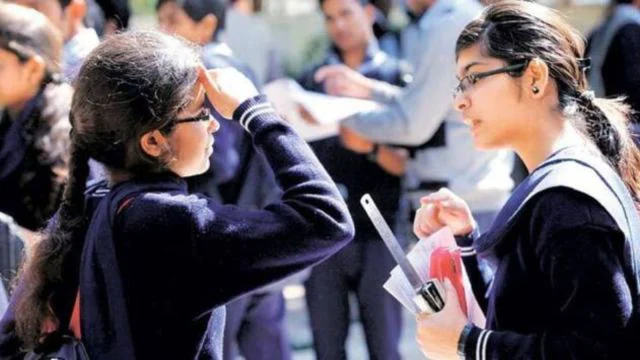Alarming Drop in School Enrollment for Third Year: Experts Blame Falling Birth Rates

Image via The Indian Express
August 29, 2025 (Friday) – School enrollment in India has dropped for the third year in a row, and the decline is raising serious concerns. Experts, teachers, and policymakers are pointing to one major reason: falling birth rates. Fewer children are being born, which means fewer children are available to join schools.
The latest data shows that enrollment in Indian schools has fallen from 25.18 crore students in 2022-23 to 24.80 crore in 2023-24, and then further to 24.69 crore in 2024-25. This steady decline is worrying because it is not just a one-time dip, but a continuing trend.
Why Enrollment is Falling Every Year
Experts explain that India is going through a demographic shift. For decades, the country had one of the highest child populations in the world. But as healthcare improves, urbanization rises, and family planning spreads, the birth rate has dropped sharply.
A lower birth rate means fewer children are entering kindergarten and primary schools. As these small numbers move up each year, the effect will be felt across all levels of schooling. This pattern is already visible in many districts.
Impact at Ground Level: Empty Schools
The impact can be seen clearly in districts such as Dakshina Kannada in Karnataka. Reports show that 90 schools in this district recorded zero admissions in the last five years. In fact, 20 schools had zero admissions in 2025 alone.
According to local rules, if a school records zero admissions for three continuous years, it can be shut down. Many aided schools are already facing closure. To survive, some schools are shifting from Kannada medium to English medium or CBSE boards in the hope of attracting more parents and students.
But even with these changes, the number of children is simply not enough. This is not just a rural issue. Even in cities, parents are choosing fewer children, and enrollment in government schools is falling.
Teachers Rising, Students Falling
Another surprising fact is that the number of teachers is increasing, even though student numbers are dropping. In the 2024-25 academic year, India crossed a historic mark of 1 crore school teachers. This is the highest number ever recorded.
But student enrollment has fallen to a 7-year low. This has created a strange situation. On one side, there are more teachers than ever before. On the other side, the number of students keeps shrinking. This could lead to imbalanced budgets, under-utilized classrooms, and unequal distribution of resources.
A Global Issue, Not Just India’s Problem
India is not alone in this challenge. Several countries are already experiencing the same crisis.
- United States: In cities like Chicago, the birth rate dropped by 43% between 2011 and 2021. As a result, many schools lost students. Some schools became so empty that the cost per student rose to shocking levels, as high as $93,000 per child in certain districts.
- Denver: School authorities have had to close schools because of falling enrollment. Officials warn of more closures and budget cuts if the birth rate continues to slide.
- Japan and South Korea: Both countries have some of the lowest birth rates in the world. Thousands of schools have either shut down or merged because there are simply no children left to teach.
This shows that falling birth rates have a direct impact on education systems worldwide. India is now beginning to feel the same pressure.
How Falling Birth Rates Affect Schools
The chain reaction is clear:
- Fewer Babies Born → Lower number of children entering pre-primary.
- Lower Kindergarten Admissions → Smaller primary school classes.
- Declining Class Sizes Each Year → Less demand for teachers in future.
- Budget Pressure → Schools spend the same amount on infrastructure, but with fewer students, the per-child cost goes up.
- Closures of Rural Schools → Remote villages lose access to local schools, forcing children to travel longer distances.
In the long term, this could change how schools, teachers, and even universities operate.
Effects on Government and Private Schools
The trend is not the same everywhere.
- Government schools are facing the sharpest decline. Parents with fewer children want to provide the “best” education they can afford. Many of them shift their child to private schools, especially in cities.
- Private schools are also feeling the heat. With fewer children, competition among private schools is increasing. Some smaller private schools may not survive if admissions continue to fall.
- Elite schools in urban centers may still do well, but they too may face smaller batches in the long run.
Numbers That Show the Scale
- Enrollment in 2022-23: 25.18 crore
- Enrollment in 2023-24: 24.80 crore
- Enrollment in 2024-25: 24.69 crore
- Teachers in 2024-25: More than 1 crore
- Zero-admission schools in Dakshina Kannada: 90 in 5 years, 20 this year
These numbers show a clear decline year after year. If the trend continues, enrollment could fall even lower in the next decade.
Possible Future Scenarios
- More Mergers of Schools – Smaller schools may be merged to save resources.
- Shift in Teaching Jobs – With fewer children, teaching jobs may stabilize or even reduce.
- Budget Reforms Needed – Governments will have to re-think how school funding is calculated.
- Urban vs Rural Divide – Urban schools may survive with quality improvements, but rural schools may close.
- Rise of Alternative Education – Online classes, homeschooling, and digital platforms may grow as traditional schools struggle with enrollment.
What Policymakers Should Do
- Track birth and enrollment trends carefully to plan ahead.
- Reform school funding models so schools with fewer students are not unfairly punished.
- Support rural schools with transport or technology to avoid closures.
- Encourage innovative teaching methods like blended learning to adapt to smaller class sizes.
- Engage communities to keep schools relevant and useful for parents.